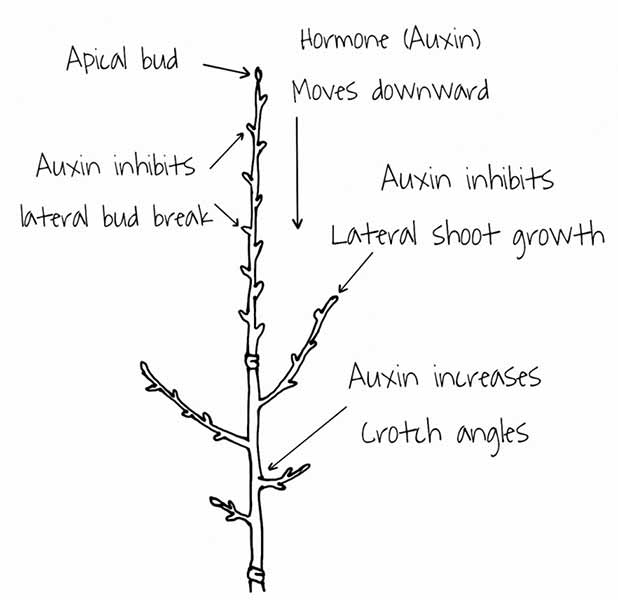Reduce water sprouts on apples and pears
Published at
The goals of any fruit tree pruning system are to:
- Create a strong branch structure to hold the growing fruit
- Create fruiting wood where you want to pick the fruit
- Allow light and air flow throughout the tree to reduce disease and maximize fruit production
Apples and pears produce fruiting wood on branches that are at least 2 years old. So, you generally want to create this fruiting wood within easy reach for harvest. Consequently, many home orchardists remove all the highest branches when they get too tall. This is exacerbated by the commonly over-simplified advice to, “remove anything that goes straight up.” The tree usually responds by sending up water sprouts, which are vigorous vertical shoots that arise from the trunk or main branches.

If you want to minimize water sprouts, apples and pears (pome fruit) should be pruned to a central leader system. This means you should maintain a central trunk with scaffold branches coming off the central trunk to hold your fruit. A strong central leader maintains what is called apical dominance. The apical bud is at the tip of the main stem. It determines the plant’s growth habit and overall form. This bud sends hormones, called auxins, downward influencing the growth of buds and branches lower on the tree. When this signal is removed through pruning, the loss of auxin flow releases other buds to aggressively grow upward…often creating water sprouts.
Apples and pears produce fruit on stubby growths called fruiting spurs. These form on branches that are two years and older and produce fruit for multiple years. Branches oriented at a 45 to 60-degree angle are most desirable. These will form fruiting wood (fruit spurs) readily. Branches oriented closer to vertical don’t produce as many fruiting spurs. Horizonal and downward growing branches will not have good auxin flow and will produce more water sprouts.

You will likely be removing some water sprouts from apple and pear trees annually. What you want to do is minimize this type of growth. Water sprouts make annual pruning a bigger job and sprouts use resources that could go into fruit production. The following summary will help you minimize water sprouts on apple and pear trees.
- Maintain a strong central leader. If your tree has been trained to have multiple trunks, establish and maintain a strong vertical growth on each of the trunks. Think of each trunk as a separate tree.
- Plant new apple/pear trees on semi-dwarf rootstock. If your rootstock is too aggressive, you will have more problems with water sprouts.
- Train branches to grow at a 45-degree angle. Weights or branch spacers can be used to increase the angle. Thin fruit from branches that are unable to hold the weight of the fruit. Sagging branches lead to water sprouts.
- Don’t prune off more than 1/3 of the vegetative canopy. Heavy pruning will cause water sprouts.
- Prune new water sprouts in the summer. The tree will be less likely to start new water sprouts in the same season.
- Prune water sprouts as close to the main trunk/branch as possible. Leaving stubs will encourage new water sprouts to grow.
In conclusion, not all vertical growth is bad. Leaving selected vertical shoots helps keep apple and pear trees with fewer water sprouts. Whenever you make a pruning cut, you are communicating with the tree. If you keep in mind auxin flow from apical buds, you can start telling the tree what you want it to do.


In the Garden is sponsored by ProPeat, which is dedicated to delivering solutions for any of your professional fertilization needs. Whether you need to reduce the harm to soils and the environment, or you're interested in the latest nitrogen, carbon and biochemical technologies, ProPeat is the perfect fit.
EastIdahoNews.com comment boards are a place for open, honest, and civil communication between readers regarding the news of the day and issues facing our communities. We encourage commenters to stay on topic, use positive and constructive language, and be empathetic to the feelings of other commenters. THINK BEFORE YOU POST. Click here for more details on our commenting rules.



